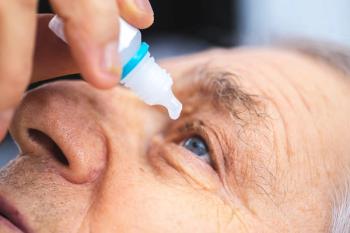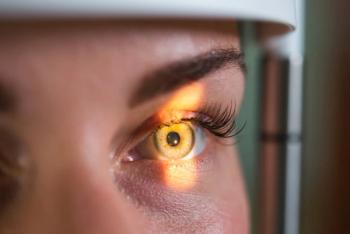
Rotational recovery key to toric lift
Results of a controlled study comparing soft toric contact lenses with different designs highlights the importance of understanding orientation recovery following lens displacement and orientation recovery following lens displacement and orientation of a settled lens.
Orlando, FL-Results of a controlled study comparing soft toric contact lenses with different designs highlights the importance of understanding orientation recovery following lens displacement and orientation of a settled lens. This understanding ensures that a selected lens will work well for the patient, said Gerard Cairns, PhD, MCOptom, FBCLA.
In a poster presented at the annual meeting of the American Academy of Optometry, Dr. Cairns and colleagues reported the results of two studies comparing primary gaze orientation and orientation recovery after intentional displacement for the PureVision Toric contact lens (Bausch + Lomb) versus the Acuvue Advance for Astigmatism and the Acuvue Oasys for Astigmatism (both Johnson & Johnson) contact lenses. The PureVision Toric is based on a Lo-Torque design, while the Acuvue products feature an Accelerated Stabilization design.
The studies enrolled a total of 32 healthy adults and tested a total of eight different power and axis combinations of each lens, representing low and high cylinders and axes of 90 and 180 degrees. A power/axis-matched pairing of a test lens (one of the two Acuvue products) and control (PureVision Toric) was evaluated in each eye of each participant with the order of the lenses randomly assigned.
All lenses tended to orient temporally. The mean absolute primary gaze orientations measured for all of the lenses was significantly different from a 0 degree position (range: 7.2 to 11.6 degrees).
Significant differences
Orientation recovery data showed statistically significant differences favoring the PureVision Toric lens over both Acuvue products in both mean orientation recovery and variability of orientation recovery, Dr. Cairns said.
In addition, and perhaps most importantly, 23% of the Acuvue Oasys lenses and 30% of the Acuvue Advance lenses did not return to within 10 degrees of the primary gaze orientation within 1 minute. Corresponding rates for the PureVision Toric Lens were 12% in one study and only 3% in the other, reported Dr. Cairns, manager, Global Medical Affairs, Bausch + Lomb Vision Care Rochester, NY.
"I know from my experience as a practicing optometrist that toric contact lens wearers may notice that their lenses become disoriented at times, perhaps as a result of eye rubbing or for some other reason, and that when this occurs, it can take time for the lenses to return to proper position and for clear vision to return," Dr. Cairns said.
"Therefore, it is important for practitioners fitting these products to realize that simply measuring orientation once the lens has settled in the eye may not give a complete picture of how well the lens performs after the patient leaves the office," he added.
"Checking rotation recovery offers a quick test of the ability of a lens to deliver stable, clear vision and insight as to how well a particular lens will perform for that patient. In addition, it may be particularly helpful for troubleshooting toric lens complaints that might be related to lens orientation issues."
In the two studies, the orientation recovery means for the PureVision Toric lens were 5.8 ± 7.3 degrees and 4.3 ± 4.3 degrees, respectively. The mean values for the Acuvue Advance and Acuvue Oasys were 10.7 ± 13.5 and 7.7 ± 7.8 degrees, respectively.
"The mean difference in orientation recovery of about 5 degrees between the Lo-Torque design PureVision Toric Lens and the Acuvue Advance Lens may be much more significant in terms of causing visual disturbance for patients with a higher amount of astigmatism. However, when we see that a significant portion of lenses with the Accelerated Stabilization Design fail to return to within 10 degrees of the primary position, this can affect all toric lens powers," Dr. Cairns said.
Newsletter
Want more insights like this? Subscribe to Optometry Times and get clinical pearls and practice tips delivered straight to your inbox.









































